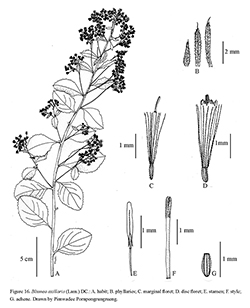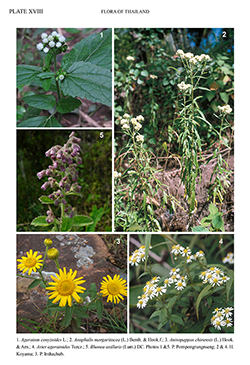e-Flora of Thailand
Volume 13 > Part 2 > Year 2016 > Page 202 > Compositae (Asteraceae) > Blumea
2. Blumea axillaris (Lam.) DC.wfo-0000068869
Prodr. 5: 434. 1836.Conyza axillaris Lam., Encycl. 2(1): 84. 1786. Fig. 16; Plate XVIII: 5.
Accepted Name : This is currently accepted.
Synonyms & Citations :
Description : Annual herb, 0.2–0.6 m tall; stems erect, with long pilose hairs and sparsely glandular hairs. Leaves petiolate; elliptic or ovate, 1–38 by 0.6–15 cm, apex acute, base attenuate, margins serrate or dentate, thinly papyraceous to thick and leathery, bright green, both surfaces pubescent with glandular hairs; petioles 0.5–1 cm long. Inflorescences terminal, narrow, loose panicles, 3–3.5 cm long. Capitula 3–5 mm diam., peduncles slender, 1–15 mm long; involucres campanulate; phyllaries 3–5-seriate, outer lanceolate with ciliate margins, 0.5–0.7 mm wide, apex obtuse to acute and puberulous, surface densely pilose with stipitate glands, inner linear-lanceolate, surface densely pilose with stipitate glands; receptacle 1.5–4 mm diam., flat, alveolate, glabrous. Marginal floret corollas purple or white, basal tube 2.7–6.2 mm long, lobes generally glabrous. Disc floret corollas purple or white, basal tube 2.4–6 mm long, glabrous, apex 5 (–6) lobed, oblong-lanceolate, 0.3–0.6 mm long, with unicellular and multicellular hairs, sometimes glabrous with glandular hairs; anthers 1–1.5 mm long, apical appendages truncate to emarginate, bases with unbranched tails, anther-tails shorter than anther collars; style arms ca 1 mm long, sweeping hairs barely reaching below style bifurcation, base swollen. Achenes oblong, terete, 0.7–1.2 mm long, pilose; pappus bristles 12–15, 2.3–7 mm long, caducous, white.
Thailand : NORTHERN: Mae Hong Son (Mae Sariang, Mo Paeng Falls), Chiang Mai (Ban Angka Noi, Chom Thong, Doi Suthep, Maesa NP, Pha Hom Pok, Om Koi along route 1099, Ban San Bong, San Sai), Chiang Rai (Ban Nong Lu), Lampang (Mae Yom); NORTH-EASTERN: Phetchabun (Thung Salaeng Luang NP), Loei (Si Than, Phu Kradueng NP); EASTERN: Ubon Ratchathani (Khemarat); CENTRAL: Krung Thep Maha Nakhon (Bangkok); SOUTH-EASTERN: Sa Kaeo (Khao Chakan Arboretum), Prachin Buri (Chakan Arboretum), Chanthaburi (Khao Soi Dao); PENINSULAR: Ranong (Klang Kamphuam, Kraburi, Bang Yai Falls).
Distribution : Africa, Madagascar, Afghanistan, China (Hainan, Guangdong, Yunnan, Sichuan, Guizhou, Guangxi, Hong Kong, Taiwan), India, Bhutan, Nepal, Pakistan, Sri Lanka, Myanmar, Indochina, Malaysia (Peninsular), Indonesia (Java), the Philippines (Luzon, Mindoro), New Caledonia, Australia (Northern Territory, Queensland, Western Australia).
Ecology : Dry rice fields, on grassy slopes or by open streams in dipterocarp forests, 160–1,400 m alt. Flowering: January–March.
Vernacular : La ong phet (ละอองเพชร)(Central).


